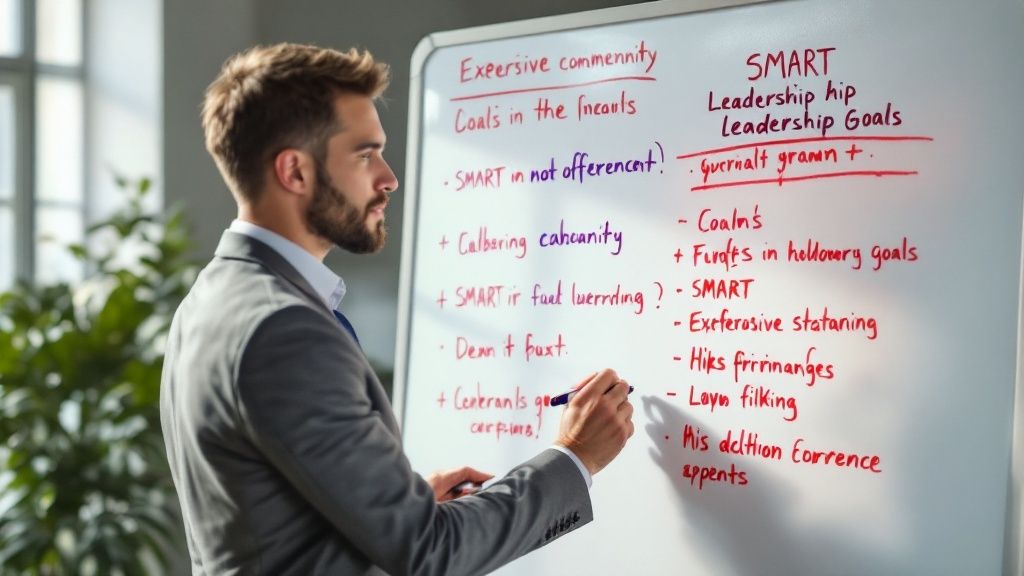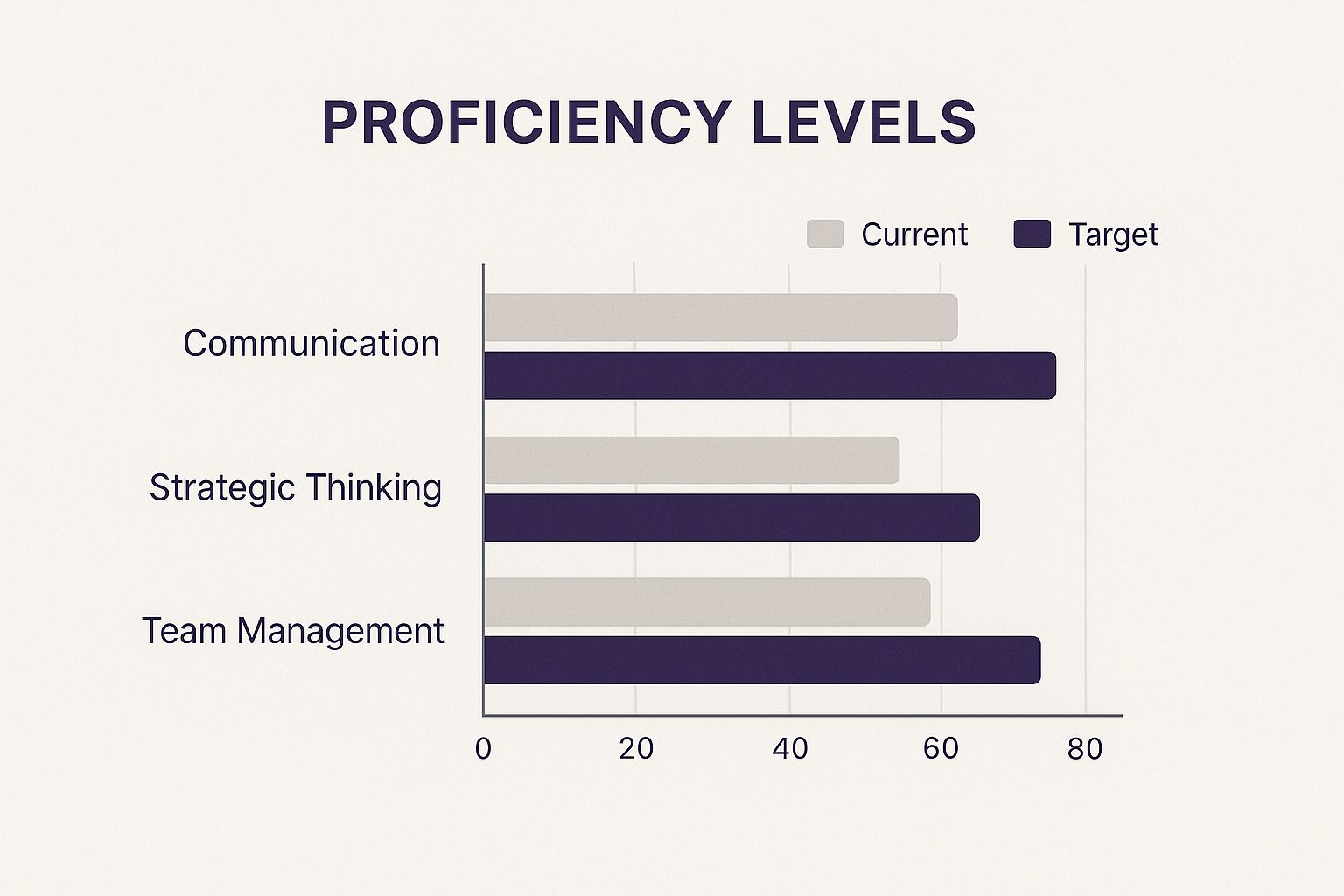Why Most Leadership Programs Fail (And How To Build One That Doesn't)

Many leadership development programs miss the mark, becoming expensive failures. This raises a critical question: what separates the successful programs from the costly ones? A primary factor is the gap between program design and organizational needs.
Generic, one-size-fits-all programs rarely cultivate meaningful growth. A sample leadership development plan, while useful as a starting point, requires careful tailoring to an organization's specific context.
Another common issue is the lack of connection between the program and real-world performance drivers. For instance, a program might emphasize theory without practical application.
Overlooking leader resistance to change is also a significant mistake. Even the best initiatives falter if leaders aren't open to new ideas. Cultivating psychological safety and showcasing the program’s value are essential for success.
The global leadership development market, valued at $366 billion by 2025 (with $166 billion in the U.S. alone), underscores the recognized importance of leadership skills. Moreover, 88% of companies plan to improve their leadership programs to maintain a competitive edge. Delaying leadership development can result in profit losses of up to 7%. You can find more statistics here: Learn more about leadership development statistics. This significant investment highlights the crucial role of well-designed leadership development plans in ensuring long-term organizational success. When transitioning from planning to execution, using established frameworks like a product roadmap can be beneficial.
Key Elements of a Successful Sample Leadership Development Plan
An effective sample leadership development plan should address these key areas:
- Clear Objectives: Define specific, measurable, achievable, relevant, and time-bound (SMART) goals.
- Targeted Skill Development: Focus on competencies essential for organizational success.
- Practical Application: Provide opportunities to use newly acquired skills in real-world situations.
- Continuous Feedback: Establish regular feedback processes to track progress and make necessary adjustments.
- Long-Term Support: Foster a culture that reinforces leadership development beyond the formal program.
Creating a successful leadership development program demands a strategic approach. It requires thorough planning, continuous evaluation, and a commitment to ongoing improvement. By avoiding common mistakes and integrating these key elements, organizations can develop programs that truly strengthen their leadership pipeline.
Building Your Sample Leadership Development Plan Framework

A robust leadership development plan isn't just a series of training workshops. It's a strategic roadmap designed to nurture the next generation of leaders. This involves aligning development initiatives with the overall goals of the business. It's about connecting existing skills with the competencies needed for organizational success.
Defining Core Competencies
Building a sample leadership development plan starts with defining the core competencies essential for effective leadership within your organization. These competencies are the fundamental elements of successful leadership. Examples include communication, strategic thinking, decision-making, and emotional intelligence.
Conducting a Skill Gap Analysis
After identifying the necessary competencies, a skill gap analysis is crucial. This analysis pinpoints the differences between current leadership abilities and the desired future state. It highlights areas where development is most needed. This focused approach makes the most of your development resources by targeting areas with the highest potential for growth.
Setting Measurable Objectives
With a clear picture of skill gaps, you can establish measurable objectives. These objectives should be Specific, Measurable, Achievable, Relevant, and Time-bound (SMART). For example, instead of a general objective like "improve communication," a SMART objective would be "increase positive feedback on communication effectiveness by 15% within six months."
Designing Development Pathways
Effective leadership development isn't one-size-fits-all. Development pathways should be personalized to individual needs and career goals. This involves providing a range of learning opportunities.
- Mentorship programs: Connecting experienced leaders with those seeking development.
- Coaching sessions: Offering personalized guidance and support.
- Stretch assignments: Challenging individuals with new responsibilities and broadening their experience.
- Formal training programs: Providing structured learning on specific leadership topics.
Creating Accountability and Feedback Mechanisms
Accountability and feedback are essential for driving progress. Regular check-ins and performance reviews provide valuable insights into individual progress toward objectives. Feedback mechanisms, such as 360-degree assessments, offer a well-rounded view of leadership effectiveness. Platforms like Happily.ai can streamline this process, offering continuous feedback and encouraging ongoing dialogue. This iterative feedback loop helps ensure continuous improvement.
To illustrate how these components can be applied across different organizational structures, let's examine the following comparison:
Leadership Development Plan Components Comparison
| Component | Small Organizations | Medium Organizations | Large Organizations | Effectiveness Rating |
|---|---|---|---|---|
| Defining Core Competencies | Often generalized due to limited roles | More specialized based on departmental needs | Highly specialized based on specific leadership levels | Varies based on clarity and relevance |
| Skill Gap Analysis | Typically informal, based on observation and feedback | More structured, using assessments and surveys | Comprehensive, involving multiple data sources and analysis tools | Generally increases with organizational size and resources |
| Setting Measurable Objectives | Tied to immediate business needs | Aligned with departmental and organizational goals | Cascading objectives linked to overall strategic priorities | Effectiveness depends on alignment and clarity of goals |
| Designing Development Pathways | Limited by resources, often relying on external programs | More diverse, offering a blend of internal and external opportunities | Highly diverse, with customized programs and internal leadership academies | Generally increases with organizational size and resources |
| Creating Accountability and Feedback Mechanisms | Often informal, relying on direct supervisor feedback | More structured, using performance reviews and 360 assessments | Formalized systems with regular check-ins and performance metrics | Effectiveness relies on consistent implementation and follow-up |
This table highlights how the implementation and effectiveness of leadership development components can vary based on organizational size and structure. While larger organizations often have more resources and formalized systems, smaller organizations can achieve strong results through focused and tailored approaches.
A well-structured sample leadership development plan creates a foundation for sustained growth, building a pipeline of capable leaders prepared for future challenges. By focusing on these essential elements, organizations can create development programs that deliver measurable results and contribute to long-term success.
Overcoming The Biggest Challenge: Leader Resistance To Change

A major obstacle in implementing any sample leadership development plan is leader resistance to change. This can arise from several sources, such as fear of the unknown, doubts about a program's effectiveness, or simply a preference for established routines. Overcoming this resistance is critical for any successful development initiative.
One significant challenge in leadership development is the reluctance of some leaders to adopt new ideas and practices. Only 29% of employees feel their leaders are receptive to outside perspectives. This highlights the need for a thorough leadership development plan that emphasizes adaptability and innovation. Moreover, organizations that invest in leadership development experience better employee retention: 58% of employees indicate they would stay longer at a company offering leadership growth opportunities. Find more detailed statistics here.
Building Psychological Safety
One effective approach is to cultivate psychological safety. This involves creating an atmosphere where leaders feel comfortable taking risks, trying new methods, and acknowledging weaknesses without fear of negative consequences. In such an environment, leaders are more likely to authentically participate in development programs and embrace new learning opportunities. Read also: How to master psychological safety.
Designing Engaging Experiences
Another crucial element is creating development experiences that leaders genuinely want to participate in. Traditional, mandatory training sessions can often generate resistance. Programs offering personalized learning, hands-on activities, and collaborative opportunities tend to be much more attractive.
Assessing Readiness and Tailoring the Approach
Assessing leaders' readiness for change is equally important. Some individuals may be more open to new ideas than others. Using this information, development plans can be adjusted accordingly, providing extra support and encouragement where needed. By framing the plan as a growth opportunity rather than a compulsory exercise, you can boost acceptance and participation. This, in turn, can result in more effective leadership development and enduring positive change within the organization.
Choosing Development Methods That Actually Stick
Forget generic training programs. Building a successful leadership development plan requires a carefully chosen mix of methods tailored to individual learning styles and growth needs. This section explores development approaches with the greatest impact, ranging from traditional classroom instruction to more hands-on, experiential learning.
Matching Methods to Competencies
Different skills require different development methods. For instance, communication skills often improve through interactive workshops and role-playing exercises, while strategic thinking can be honed with case studies and simulations. A well-designed leadership development plan should always align the chosen method with the specific competency being targeted.

This infographic illustrates the gap between current and target proficiency levels for Communication, Strategic Thinking, and Team Management. As you can see, current communication skills are relatively close to the target. However, significant development is needed in both strategic thinking and team management.
Utilizing a Blended Learning Approach
A blended learning approach combines a variety of methods and often yields the best results. This might include online learning modules, in-person workshops, individual coaching sessions, and practical on-the-job training. Diversifying the learning experience caters to various learning styles and reinforces key concepts through multiple channels. You might be interested in: How to master employee recognition.
Leveraging Coaching and Mentoring
Coaching provides personalized guidance focused on developing specific leadership skills. Mentoring, on the other hand, offers broader career advice and support drawn from the mentor's own experience. Integrating both coaching and mentoring into a leadership development plan can substantially accelerate professional growth.
Designing Meaningful Stretch Assignments
Stretch assignments push leaders beyond their current comfort zones, offering valuable opportunities to apply new skills in real-world scenarios. These assignments should be challenging but attainable, with adequate support and guidance provided to ensure success.
Integrating Technology Tools
Technology is essential for modern leadership development. Platforms like Happily.ai can facilitate feedback, monitor progress, and provide convenient access to learning resources. Investing in appropriate technology streamlines the development process and improves engagement.
To help visualize the benefits of different leadership development methods, let's review the following matrix. It analyzes the effectiveness, cost, and time commitment of each method to help you build the most impactful development plan.
Leadership Development Methods Effectiveness Matrix
| Development Method | Effectiveness Score | Cost Level | Time Investment | Best For |
|---|---|---|---|---|
| Classroom Training | Medium | Medium | Medium | Foundational knowledge |
| Workshops | High | Medium | Low | Skill practice and application |
| Role-Playing | High | Low | Low | Interpersonal skills |
| Case Studies | Medium | Low | Medium | Strategic thinking |
| Simulations | High | High | Medium | Complex decision-making |
| Coaching | High | High | Low/Medium | Individualized development |
| Mentoring | Medium | Low | Low/Medium | Career guidance |
| Stretch Assignments | High | Low | High | Real-world application |
| Online Learning | Medium | Low | Low | Flexible learning |
| Action Learning Projects | High | Medium | High | Problem-solving and teamwork |
This matrix helps illustrate how various methods can be combined to create a well-rounded development experience. For example, pairing classroom training with stretch assignments can bridge the gap between theory and practice. Similarly, combining coaching with online learning can offer both personalized support and flexible access to resources.
Action Learning and Feedback Mechanisms
Action learning projects enable leaders to tackle real business challenges while simultaneously developing their leadership skills. When combined with robust feedback mechanisms, like 360-degree assessments, these projects deliver valuable insights and accelerate professional growth. This iterative cycle of action, feedback, and improvement keeps the leadership development plan relevant and highly impactful.
Measuring What Matters: Tracking Real Leadership Growth
A common mistake in leadership development is focusing on measuring activities instead of actual impact. Simply completing training modules or attending workshops isn't a true measure of success. A strong sample leadership development plan emphasizes metrics that demonstrate genuine growth in leadership. This requires going beyond traditional performance reviews and using more insightful assessment methods.
Establishing Meaningful Baselines
The first step in tracking real growth is establishing meaningful baselines. This means assessing current leadership competencies before any development initiatives begin. These baselines provide a starting point for measuring progress and give context for evaluating future performance. It’s like setting the zero mark on a ruler, giving you a reference for all future measurements.
Setting Realistic But Challenging Milestones
Once you have your baseline, you need to establish SMART milestones—Specific, Measurable, Achievable, Relevant, and Time-bound. These milestones should push individuals to grow while remaining attainable to maintain motivation. An example of a milestone might be "improve team project completion rates by 10% within the next quarter." This provides a tangible target to work towards.
Creating Feedback Loops That Inform Continuous Improvement
Feedback loops are crucial for continuous improvement. Regular check-ins, 360-degree assessments, and pulse surveys provide valuable data on leadership progress. Use this data to adjust the development plan, ensuring it stays relevant and effective. This creates an iterative cycle of learning, feedback, and adjustment. For more information, check out this article: How to master measuring culture.
Tracking Individual and Team Outcomes
Leadership development should positively affect individual leaders, their teams, and the organizations they lead. Tracking both individual progress and team/organizational outcomes is critical. For example, consider if team members are reporting higher engagement levels and whether overall team performance is improving. These metrics provide a comprehensive view of the development plan’s effectiveness.
Demonstrating ROI
Demonstrating return on investment (ROI) is often essential, particularly when seeking buy-in from stakeholders. Connect leadership development outcomes to tangible business results, such as increased productivity, improved employee retention, or higher customer satisfaction, to demonstrate the program's value. This data-driven approach strengthens the case for continued investment in leadership development.
Practical Tools for Tracking Progress
Several tools can effectively help track leadership development progress:
- Performance Management Systems: Adapt these systems to track development goals and create a central platform for feedback and progress monitoring.
- 360-Degree Feedback Tools: These tools provide a comprehensive perspective on leadership effectiveness by gathering feedback from multiple sources.
- Pulse Surveys: Regular pulse surveys can monitor changes in team morale, engagement, and performance, offering insight into leadership development’s impact.
- Platforms like Happily.ai: Happily.ai provides integrated tools for feedback, recognition, and engagement, streamlining progress tracking and facilitating continuous improvement.
By focusing on these methods, you can create a sample leadership development plan that goes beyond simply checking boxes and cultivates substantial growth. This approach ensures the development initiative delivers lasting value for both individual leaders and the organization as a whole.
Creating Leadership Development That Lasts
The true measure of any leadership development plan lies in its long-term effects. What happens after the formal training is crucial. This section explores how organizations create lasting leadership cultures, extending development beyond structured programs.
Building Ongoing Support Systems
Sustainable leadership development needs ongoing support. This could involve mentorship programs, internal leadership communities, or access to coaching. These systems ensure leaders receive guidance even after formal training concludes. Think of it as providing continuous support as they progress in their leadership journey.
Establishing Peer Networks
Peer networks offer invaluable growth opportunities. Regular peer learning sessions, group coaching, or informal networking events build a sense of shared learning and mutual support. This collaborative approach strengthens the leadership community, allowing individuals to learn from each other's experiences.
Reinforcing Leadership Behaviors Through Organizational Processes
Integrating leadership development principles into daily operations reinforces desired behaviors. This could involve including leadership competencies in performance reviews, linking promotions to demonstrable leadership skills, or designing collaborative work processes. Learn more in this article about creating a feedback culture. This makes leadership development an integral part of the organization.
Fostering a Culture of Leader Development
Successful companies empower leaders to develop other leaders. Creating opportunities for experienced leaders to mentor or coach colleagues expands the reach of development efforts. This cultivates continuous growth, with leadership development becoming an organic process. It's a cycle where development fuels further development.
Adapting to Evolving Needs
Organizational needs change. Leadership development strategies must adapt. This involves regularly evaluating the development plan's effectiveness and adjusting the approach as new challenges and opportunities arise. This keeps the plan relevant and ensures it meets the organization's changing needs.
Building Sustainable Leadership Communities
Sustained growth requires strong leadership communities. These communities provide ongoing learning, create a sense of belonging, and foster a shared commitment to leadership excellence. They offer vital support during changing business conditions, ensuring leadership development remains a priority. This could involve regular leadership forums, online communities, or internal mentorship networks. Building these foundations ensures leadership development programs create a lasting legacy of growth and impactful leadership. This fosters a culture where leadership thrives not just during formal programs but as a continuous process.
Your Implementation Roadmap: From Plan To Action
You now understand the elements of a solid sample leadership development plan. This section offers a practical roadmap for putting your plan into action, preventing it from becoming overwhelming for your organization or budget. We'll break the process into manageable phases, prioritizing initiatives based on your current resources and available capabilities.
Phase 1: Building Foundation and Securing Buy-In
First, solidify the core elements of your sample leadership development plan. Define the leadership competencies vital to your organization’s success. For example, is communication, strategic thinking, or adaptability most crucial? Next, perform a skill gap analysis to identify areas that require development. This involves evaluating the current state of leadership skills and comparing it against your desired future state.
Securing stakeholder buy-in is essential for both resource allocation and long-term program support. Clearly communicate the program's value and how it aligns with organizational goals. Highlighting potential ROI through metrics like improved performance or increased employee retention can be extremely effective. Creating a lasting leadership development plan also involves considering long-term implications, similar to the process outlined in this article on estate planning for families.
Phase 2: Designing the Development Journey
With stakeholder support secured, you can design the actual development journey. Select development methods that align with your organization’s culture and resources. This might include workshops, coaching, mentoring, online learning platforms, or a combination of these approaches. Ensure the chosen methods effectively address the identified skill gaps.
Establish clear, measurable objectives for each phase of the plan. These objectives provide a roadmap for participants and serve as benchmarks for evaluating progress. For example, an objective might be, "Participants will increase their scores on a strategic thinking assessment by 15% within six months." If strategic thinking is a key development area, consider incorporating case studies and simulations into the program.
Phase 3: Implementation and Ongoing Refinement
The implementation phase involves launching the plan and consistently monitoring its effectiveness. Regular communication with participants and stakeholders is vital during this stage. Set up feedback mechanisms to gather data and pinpoint areas for improvement. This data-driven approach ensures the program adapts to changing needs and maximizes impact. Consider platforms like Happily.ai to streamline feedback collection and progress tracking.
Anticipate potential challenges during implementation and create contingency plans. For instance, address potential resistance to change from some leaders proactively with clear communication and support. This proactive approach will help ensure a smoother implementation process.
Timeline and Resource Allocation
A realistic timeline is key for effective implementation. Account for the duration of each development activity, including any necessary follow-up or reinforcement. Allocate resources strategically, balancing the costs of various development methods with their potential ROI.
| Phase | Activities | Timeline | Resources |
|---|---|---|---|
| Phase 1 | Competency Definition, Skill Gap Analysis, Stakeholder Buy-In | 2-4 weeks | HR Team, Leadership Team |
| Phase 2 | Development Method Selection, Objective Setting, Program Design | 4-8 weeks | L&D Team, External Consultants (if needed) |
| Phase 3 | Program Rollout, Feedback Collection, Ongoing Refinement | Ongoing | HR Team, Program Facilitators, Happily.ai platform |
By following this roadmap, you can transform your sample leadership development plan into tangible organizational change, developing stronger leaders and driving measurable results.
Ready to enhance your leadership development program and cultivate a thriving workplace culture? Discover how Happily.ai can help.









